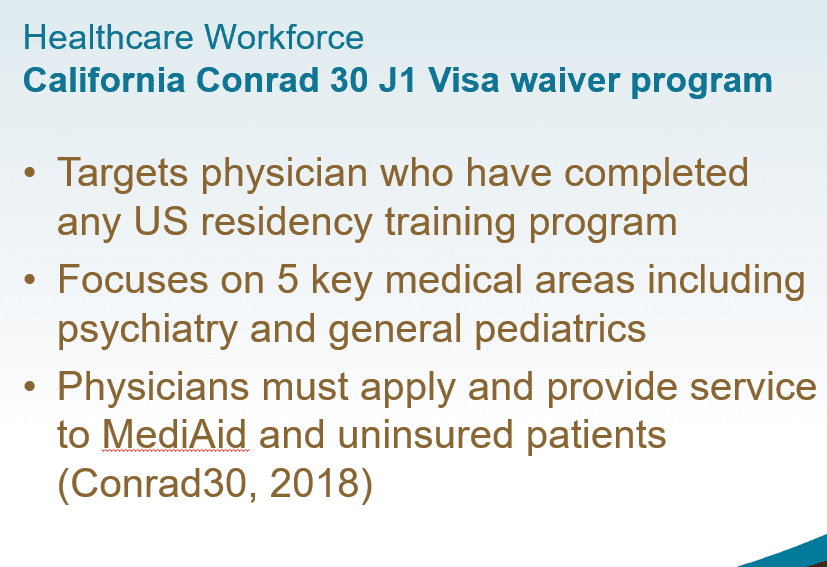Healthcare workforce
In areas where access to care may be limited, partnerships play a major role in ensuring that patients are given the best care possible. In Case Study Profile 1, for example, a nurse, two doctors, a diabetes program coordinator, and a health education program all collaborate as one healthcare team working with a single patient. These partnerships are invaluable in circumstances where quality care may be hard to acquire. In addition, legislation like the Conrad 30 waivers and J-1 visas can provide additional avenues to for underserved populations to receive care, as demonstrated in Profile 3.
For this Assignment, you will examine data from your own community surrounding workforce shortages and underserved populations/areas. You will also identify mechanisms, programs, and partnerships that exist to address these issues.
To prepare:
Review the “State Primary Care Offices” (U.S. Department of Health and Human Services, 2018) website provided in this week’s resources.
Review information available from your state of residence or a state of interest with a focus on the following:
Conrad 30 Waiver Program and J-1 visas
Medically Underserved Areas/Populations (MUA/P) and Health Professional Shortage Areas (HPSA)
Explore the Bureau of Labor Statistics to research workforce shortages specific to health.
Reflect on the role of health educators in fostering partnerships with the healthcare workforce in these areas to promote population health efforts.
Review the case study profiles in this week’s resources and reflect on the necessary elements required for successful partnerships among healthcare professionals to address population health.
Research examples of health education programs that have successfully fostered partnerships with the healthcare workforce to address population health in the state you selected.
The Assignment: (5–7 PowerPoint slides)
Create a PowerPoint presentation, with speaker notes, for health educators and health administrators practicing in your selected state. In your presentation, address the following points:
Explain policies in your selected state, such as the use of Conrad 30 waivers and J-1 visas.
Describe the current status of your selected state’s MUAs, MUPs, and HPSAs.
Provide an example of a health education program that is current and explain how it promotes partnerships with the healthcare workforce to enhance population health initiatives in the state you selected.
PRACTICAL PLAYBOOK. (2017). RETRIEVED FROM HTTPS://WWW.PRACTICALPLAYBOOK.
U.S. BUREAU OF LABOR STATISTICS. (2018). RETRIEVED FROM HTTPS://WWW.BLS.GOV/HOME.HTM
NOTE: EXPLORE THE BUREAU OF LABOR STATISTICS WEBSITE TO RESEARCH WORKFORCE SHORTAGES SPECIFIC TO HEALTH.
U.S. DEPARTMENT OF HEALTH AND HUMAN SERVICES, HEALTH RESOURCES & SERVICES ADMINISTRATION. (2018). STATE PRIMARY CARE OFFICES. RETRIEVED FROM HTTPS://BHW.HRSA.GOV/SHORTAGE-
WALDEN UNIVERSITY. (2017). SEARCH RESULTS FOR: POWERPOINT PRESENTATION. RETRIEVED FROM HTTP://ACADEMICANSWERS.
NOTE: EXPLORE THE SEARCH RESULTS AT THIS LINK FOR SUPPORT RESOURCES ON PREPARING A POWERPOINT PRESENTATION.
WASHKO, M. M., & FENNELL, M. L. (2017). THE EPICENTER OF EFFECTIVENESS AND EFFICIENCY IN HEALTH CARE DELIVERY: THE EVOLVING U.S. HEALTH WORKFORCE. HEALTH SERVICES RESEARCH, 52(S1), 353–359. DOI:10.1111/1475-6773.12662
NOTE: YOU WILL ACCESS THIS ARTICLE FROM THE WALDEN LIBRARY DATABASES.
Solution preview for the order on healthcare workforce
7 slides
